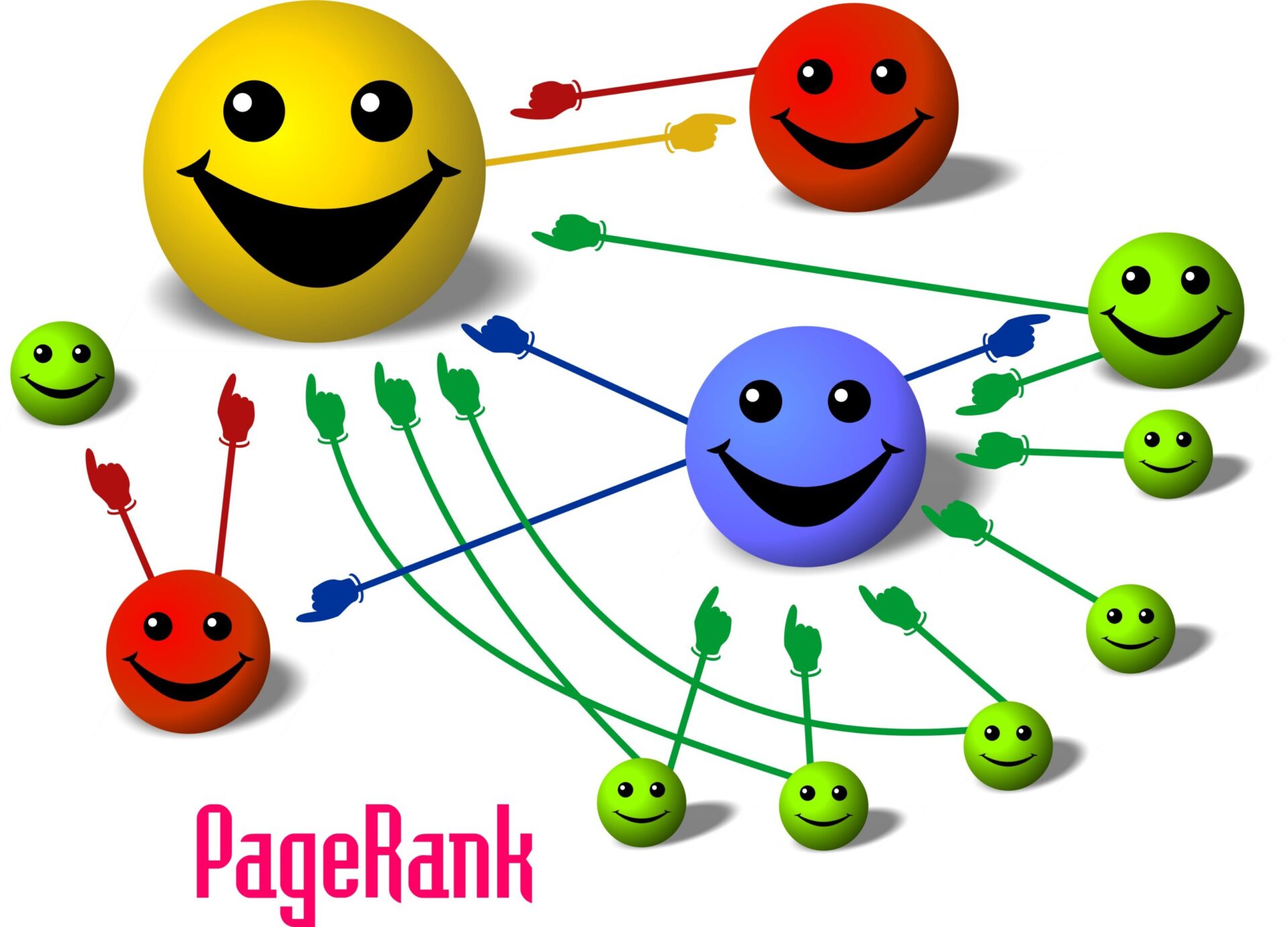SEO for the Property Sector Part Five: Links and External SEO
The web's intricate system of hyperlinks ('links') is what makes it possible for modern search engines to operate. And the quality, diversity and number of links pointing at your site can play a huge role in determining where you'll appear in search results for any given query.
In this section of our guide, we'll take an in-depth look at the role links play in SEO for property companies and offer advice on the best and most sustainable ways to acquire these.
What's in a link?
At their most basic, hyperlinks are simply a way of connecting one 'hypertext document' (a website) to another. They're activated by clicking on something – be it a highlighted word, image or button.
As mentioned in the theory section of our guide, search engines utilise autonomous software programs ('bots' or 'spiders') that periodically scan the web by following hyperlinks from one site to another.
By analysing these connections, the likes of Google can find out how one page relates to another and through taking into account the number, quality and diversity of links – go some way towards determining how popular a website is.
 Why they're important
Why they're important
While links are only one factor among the 200+ that Google takes into account when ranking your web pages for a given query, it's commonly asserted that they carry a great deal of 'weight'.
Indeed, in industry stalwart Moz's latest Search Ranking Factors survey 'page link authority features' were the highest correlated factor.
By using links, Google can go some way to assessing how popular your site is, how trustworthy it's likely to be and how authoritative it is in regard to a specific query.
Link Building
Given that links from sites with favourable statistics can pass PageRank (also known as 'link juice' or 'SEO juice') and make your site appear better in the eyes of Google, it's no surprise that acquiring these links – a process commonly referred to as 'link building' or 'external SEO' – is one of the most favoured tactics in modern SEO.
In fact, link acquisition became so rampant that last year, Google stepped in to highlight some tactics it didn't approve of, noting that sites that engaged in these could have their search result rankings negatively impacted.
"Any links intended to manipulate PageRank or a site's ranking in Google search results may be considered part of a link scheme and a violation of Google's Webmaster Guidelines. This includes any behaviour that manipulates links to your site or outgoing links from your site," it said.
The big G went on to highlight several popular activities that could land you in search engine trouble, including:
- Buying or selling links that pass PageRank
- Excessive link exchanges
- Large-scale article marketing (where you offer to write a guest post for someone else's site in exchange for a link)
- Using automated programs or services to create links to your site
- 'Unnatural' links that weren't editorially placed or vouched for by the site's owner
There's obviously some room for interpretation with the above and while many sites have received penalties (both manual and automated), lots of these tactics are still in use – and producing effective results – today.
While you can try your luck, there's every possibility (and some fairly forthright indications) that Google will take further steps to clamp down on this in the future, so it's something of a gamble.
 Algorithm Updates
Algorithm Updates
In order to curtail tactics it doesn't approve of – while continuing its mission to provide the most relevant results to searchers – Google frequently updates its algorithm (the maths that makes the search engine work).
These can be as small as a simple 'data refresh' – whereby Google updates the information on its hardware – or as ambitious as the named Hummingbird Update, which stood as an entirely new algorithm (although it retained several elements from the previous iteration).
As Google's capabilities have grown, the rate at which it rolls out updates has steadily increased – with certain algorithm changes and tweaks prompting daily alterations to the way search results are organised.
While we won't delve into the nitty gritty of Google's legion of colourfully-named updates, it's well worth going over a few of the more recent ones to give you a picture of the current search landscape and the standpoint the search behemoth has taken on combatting 'webspam' (any activity aimed at maliciously manipulating search results).
Caffeine: This 2010 update marked a dramatic change in the way – and how often – Google was able to crawl the web. This gave webmasters an incentive to update their site more often and helped Google keep up with people's growing expectations of search as video, images and other multimedia elements became more prevalent.
Panda: One of the big G's major steps in tackling "black hat" SEO tactics, Panda affected up to 12% of search results and focused on penalising low-quality sites, those which hosted duplicate content or 'thin' content that didn't appear to meet the needs of searchers.
So what makes a high-quality site? Google itself offered guidance to those looking to avoid punishment from Panda or other updates of its ilk, proffering nuggets like:
"Search is a complicated and evolving art and science, so rather than focusing on specific algorithmic tweaks, we encourage you to focus on delivering the best possible experience for users."
It also put together a checklist for those looking to assess their site, listing criteria that included:
"Is this article written by an expert or enthusiast who knows the topic well, or is it more shallow in nature?
Does the page provide substantial value when compared to other pages in search results?
Would you recognize this site as an authoritative source when mentioned by name?
Are the pages produced with great care and attention to detail vs. less attention to detail?"
Penguin: To combat sites that attempted to game the system and use links to manipulate their placement in search results – the 2012 Penguin update largely focused on devaluing low-quality, paid-for or 'unnatural' links.
If sites were found to be hoarding these types of links – even on a single page – Google's "trust" in the whole domain was reduced and they could soon expect search performance to plummet as a result.
Manual Actions: In addition to algorithmically detecting and penalising tactics it doesn't approve of, Google can also issue 'manual' penalties to websites that it thinks aren't playing ball.
Depending on where you've slipped up, the penalty might only affect specific pages, while in other cases you could see a site-wide drop in search result rankings.
If you do fall foul of one of these, it's possible to address the specific issue and then reach out to Google with a reconsideration request. Once submitted, its employees will assess your site (usually within two-to-three weeks) and let you know whether or not you've done enough to warrant a retraction of the penalty.
What does a penalty look like?
Being penalised by Google – whether manually or algorithmically – basically equates to a drop in your website's visibility in search results and a corresponding fall-off in the amount of traffic being driven to your site from organic search channels.
While a page-specific penalty will only affect the offending page – a site-wide penalty will impact the entire domain and in the worst cases – result in removal from Google's index altogether.
If you're subject to a manual penalty, Google will kindly notify you of this in Webmaster Tools. However, if your site or specific pages are being devalued algorithmically, you'll get no notifications and will have to infer what's wrong from analytics data. If the effect is minor, it can be particularly hard to differentiate from your site simply being outgunned by competitors. And unless you know you've done something Google would disapprove of recently (e.g. setting up a load of low-quality, unnatural links on third-party sites) it might go unnoticed.
A Real Life Example
Back in 2013, flower delivery giant Interflora was subject to a high-profile penalty, which saw it banished from terms that it had previously ranked highly for – even including its own brand name.
The consensus is that this occurred due to the company's aggressive link building strategy of posting advertorials with PageRank-passing links across more than 150 regional news sites in the UK.
In the wake of the debacle, Google's head of web spam Matt Cutts took the opportunity to reiterate the search giant's dim view of purchasing links in a blog post.
Negative SEO
A spectre is haunting online marketing, the spectre of negative SEO.
Given that Google made its dim view of low-quality links pretty clear – it didn't take nefarious black hat practitioners long to attempt to demolish the rankings of competitors by pointing spammy links at their websites.
This practice, known as 'negative SEO', has hit the headlines recently (in search-related publications at least) – with several intriguing case studies coming to light.
While there's a lot of hype – it's hard to say how prevalent this practice is. One survey conducted by Search Engine Roundtable polled just over 300 webmasters, nearly 50% of whom claimed they had tried negative SEO and were able to negatively impact a third-party site.
It's also worth noting that Google has been forced to acknowledge this vulnerability – changing its guidance for webmasters over the years:
"There is nothing a competitor can do to harm your ranking or have your site removed from our index." – Google pre-2003
"There is almost nothing a competitor can do to harm your ranking." – Google post-2003.
And then in 2012, the search engine stalwart took it a step further, changing its advice to state:
"Google works hard to prevent other webmasters from being able to harm your ranking or have your site removed from our index. If you're concerned about another site linking to yours, we suggest contacting the webmaster of the site in question. Google aggregates and organizes information published on the web; we don't control the content of these pages."
If your site is unfortunate enough to become the target for a legion of spammy links, there's no way to appeal to Google. Instead, you'll have to contact the webmaster of the site(s) in question and ask for them to be removed or use Google's Disavow Tool.
The ins and outs of combatting negative SEO are a bit on the technical side, but there's some great guides available if you're interested in drilling down into this fascinating topic.
So will this worrying, if somewhat small-scale, trend prompt Google to review the way it uses links as a ranking factor? Maybe.
Despite its inscrutability about the inner workings of its algorithm, we know Google's getting better at paying attention to things beyond mere links so it's entirely possible that the coming years could herald some exciting changes in the way the world's favourite search engine works.
How to build sustainable links
So we've hopefully imparted that links are important, but acquiring them in the right way and not stepping on Google's metaphorical toes while you do it is an equally crucial concern.
Back in 2013, the search giant quietly tweaked its advice to webmasters in this regard. A message that previously stated:
"In general, webmasters can improve the rank of their sites by increasing the number of high-quality sites that link to their pages."
Was changed to:
"In general, webmasters can improve the rank of their sites by creating high-quality sites that users will want to use and share."
While link building still currently 'works' in terms of increasing a website's ranking potential, this change in advice could be taken to herald Google's future direction – where it could pay more attention to data on how users interact with sites and results, get better at detecting 'implied links' like brand mentions – or put more emphasis on factors beyond links.
This is all speculation, however, and in the meantime – if you're not building links, your competitors probably are.
There's two schools of thought on this front. The first is to play things strictly by the book and simply focus on creating great content that speaks to your key audiences and compels them to spontaneously generate social shares and links by virtue of its quality.
And while this is the ideal, it's no easy feat. Massive companies throw millions at developing comprehensive content strategies and whether you take this in-house or outsource – developing the kind of content that generates natural links will cost you a pretty penny in terms of both time and money.
The second option is to seek out links without falling foul of Google's warnings about unnatural links. There's a range of tactics in this regard and just some of the most popular include:
Guest posting: Whether you seek out the opportunity or are invited – guest posting means providing commentary or a full-blown editorial piece for a third-party website, which then provides a link to your domain.
However, this tactic has been the target of much abuse from link-hungry SEOs, so be careful where you post and stick to relevant, authoritative domains as much as possible.
Reverse Guest Posting: Where you invite someone to provide editorial for your site, in the hopes that they'll link to your domain in a write-up (e.g. 'Check me out writing for RDPR in this article').
Social Shares: As mentioned in previous entries, while the debate rages on about how (and even if) Google pays attention to links generated via social channels – social activity can be a good source of links. Indeed, research from Moz suggests that content that earns endorsements on Google+ can positively impart some SEO benefits.
PR: Generating real-world coverage of news, research or an event can be a great way to earn natural links from authoritative sources, but its need for multi-disciplinary expertise and cooperation can be a challenge.
Embeddables: Infographics, multimedia and basically anything else that can be embedded on third-party websites can be a great source of links. Simply create something worth sharing and then encourage others to re-share it on their own sites with a handy bit of code that ensures you get the credit (and a link).
What next?
While this marks the end of our foray into the basics of SEO for the property sector, we're more than happy to answer any questions you might have – so be sure to leave us a comment below or give us a shout on Twitter.
And if you're looking to get a leg up on your online competitors by improving your search performance or simply want to find out more about digital marketing, be sure to download our free guide for property companies today:

Images used courtesy of Wikimedia Commons and Dave Naylor.
Selected industry experts bring you insight and expert advice, across a range of sectors.
Subscribe for free to receive our fortnightly round-up of property tips and expertise
Selected industry experts bring you insight and expert advice, across a range of sectors.
Subscribe for free to receive our fortnightly round-up of property tips and expertise



